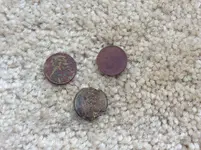I can't point you to an article, but I can provide some insight on what you are seeing....
1- US pennies changed from a copper alloy to a zinc planchet with a copper cladding in 1982. So any 1983 (and a few 1982s as they were mixed that year) and newer like to self destruct because the addition of conductive moisture (aka ground water) causes them to become a tiny battery which eats its self. 1982 and older still look like solid coins.
2- copper corrodes from exposure to the combination of moisture, minerals and oxygen. As these can vary from one location to the next, the amount of corrosion will always vary.
3- modern clad coins (copper core with cupro-nickle front and back) are typically very stable in most ground conditions. Highly corrosive ground and salt water will eat away the copper core must fast so you can find ones that look like oreo cookies.
- The cupro-nickle cladding reacts with moisture and minerals to create a dark brown/black staining
4- older silver coins very frequently come out of the DIRT as shiny as the day they were dropped, but it the ground is constantly wet, the can turn black from sulfur contamination. Silver LOVES sulfur.
Every site is different and soil conditions can change very quickly within a single site. I have dug IH cents in almost perfect condition as well as old wheat cents that still have some original shine to them. Then 50 foot away you can dig another of the same that is so corroded its almost impossible to determine what it is.





